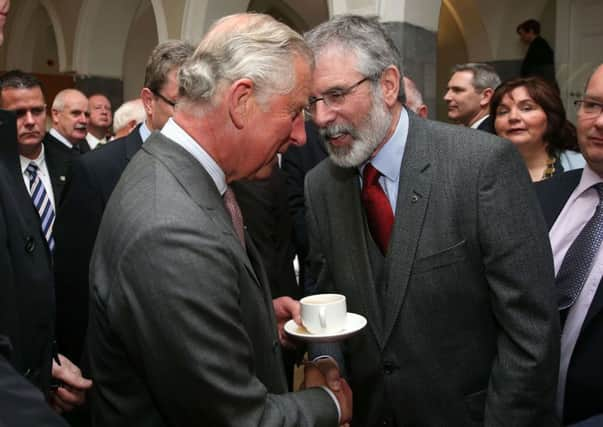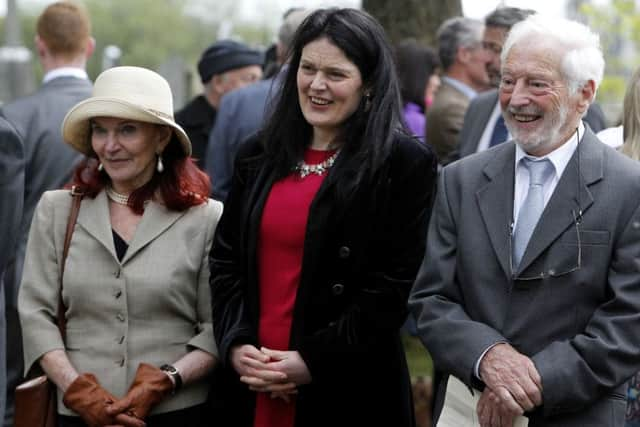John Mullin: The hand shake that shook the world


Anyone can make a mistake: there but for the grace of God. But the Washington Post – which brought down a US president – suffered an embarrassing blip this week.
They – like everyone else – were fascinated by the historic (and it truly was) meeting in the Irish Republic on Tuesday between Prince Charles and Gerry Adams, Sinn Fein president. But the scene-setter on the Post’s website would have had its late editor Ben Bradlee birling in his grave.
Advertisement
Hide AdAdvertisement
Hide Ad“Prince Charles is to meet Sinn Fein president Gerry Adams today to promote ‘reconciliation and healing’,” it read. It noted that Charles – yes, Charles “has always denied he’s a member of the IRA” Come again? Cue red-faced correction.


All the media had fun with the momentous tryst. Why not? There was something surreal about the orchestrated spontaneity when the future King of Britain and Northern Ireland just happened to bump in to a former member of the IRA’s ruling army council.
They shared a 13-second handshake – too long, surely? – as Charles balanced his tea cup and saucer in this left hand. Adams bent in, and said: “Welcome back to Ireland,” in Irish and then in English. Then, we know not what.
Jonathan Jones, in the Guardian, rejoiced. “Once the images were of soldiers in armoured cars and bomb-shattered pubs. Now we watch two men, both getting older, shaking hands, their words a murmured secret reconciliation. In all the bloody scenes of this unforgiving world, this was a tea-time miracle.”
The Daily Mail’s Stephen Glover was at gas mark 11: “How can there be meaningful forgiveness when one of the parties refuses to acknowledge the monstrous things that it did. The handshake between Prince Charles and Adams would have some significance if the former IRA terrorist were prepared to confront what he had done, to apologise – and mean it.”
My mind wandered back to a Monday afternoon in late October 1993. I was in Glasgow, and my paper sent me along to see Charles open a new housing development. I had never seen him in action before, and sharpened my pen, ready for a demolition job on the prince as he met Partick folk.
He was – to my astonishment – charming, funny, kind and interested, and, while Glasgow people will welcome anyone, they really did rather adore him. So much for my lofty preconceptions.
A few minutes after filing my article, I was scrambled. It was two days after the Shankill Road bombing, an IRA attack which left ten dead, and I was sent to help out in Belfast.
Advertisement
Hide AdAdvertisement
Hide AdThree days after I watched Charles in action, Adams carried the coffin of Thomas Begley, the republican bomber who had killed himself in the attack. Adams’s act was fearsomely controversial, and it was a truly terrible time in Northern Ireland. That week, 23 people died. The horror culminated in one of the worst atrocities of the Troubles: a loyalist attack at the Rising Sun pub in Greysteel, County Londonderry, on Hallowe’en.
Eight perished in what became known as the “Trick or Treat” massacre. That is what the UDA gunmen shouted as they began spraying their bullets.
I remember the morning afterwards, the anguish at the Star of the Sea church, where SDLP leader John Hume broke down, and then I visited the families of the victims.
First, there was Jimmy McHugh, dignified, heartbroken, the pub owner. His dad, James, 81, was killed, one of the oldest victims of the Troubles.
Then, there was Gillian Burns, just 14. She was busying herself making tea for visitors; her dad, John, dead, and her mother, Nellie, fighting for life, in Altnagelvin Hospital.
Most of all, though, I remember Joe McDermott, shot dead as he enjoyed his one real luxury: a Saturday night pint of Guinness.
Joe had been a ladies’ man once. He was handsome and strong and had earned a few bob as a boxer.
He did what good neighbours do. He had helped an old lady next door when she was dying of cancer, lighting her fire every morning and doing all her shopping.
Advertisement
Hide AdAdvertisement
Hide AdBut Joe had never been quite right since he had been knocked down many years earlier. His house was derelict and overrun with cats: scores of them. I stopped counting at 57.
The next day, Joe was receiving visitors at what had been the family house. His brother shook my hand, thanked me for coming and ushered me upstairs. This wasn’t quite what I had anticipated, and I hesitated on the stairs for a second. I had never seen a dead body before.
They had laid Joe out in a grey jacket, white shirt and fancy blue tie, here in the bedroom where he had been born 54 years earlier. He was clutching the rosary, his right hand missing three fingers, the legacy of an accident while chopping wood.
The house thronged with visitors, who all clearly loved him. Proper, decent people.
Stephen Glover’s position is understandable: Adams has many secrets and how he has reacted to child abuse allegations against his brother and within the republican movement has been shameful.
Charles, though, like his mother, is a Class Act. The Queen went to Dublin four years ago, the first visit by a British monarch to Ireland in almost 100 years. It was fraught with potential difficulties.
But she charmed the Irish. Not only did she speak in Gaelic, but she visited the graveyards of IRA members who died fighting the British. Breathtaking, really. Sinn Fein stayed away, and it showed them up as small-minded.
Charles visited Mullaghmore in County Sligo, the day after having tea with Adams. The IRA blew up his beloved uncle Earl Mountbatten and three others as they went fishing on the Shadow V in August 1979. It must have been tough.
Advertisement
Hide AdAdvertisement
Hide AdBut he had the privilege to meet Mary Hornsey, mother of Paul Maxwell, just 15 when he died alongside Earl Mountbatten in that attack. She spoke beautifully about her son living with her always – the first thing she would do when she awoke was talk to his photograph. It was quite enough to bring a tear to a glass eye, as my old dad would have said.
As did that erroneous Washington Post article, she too referred to reconciliation and healing. If there is none, it is the proper, decent people – like Mary Hornsey or Joe McDermott – who pay.
That week when I first saw Charles and Adams up close was to prove a watershed in Northern Ireland.
There would be atrocities in Loughinisland and Omagh and more killings besides.
But it was never to be quite as bad again.
The darkest hour was followed by a new dawn.